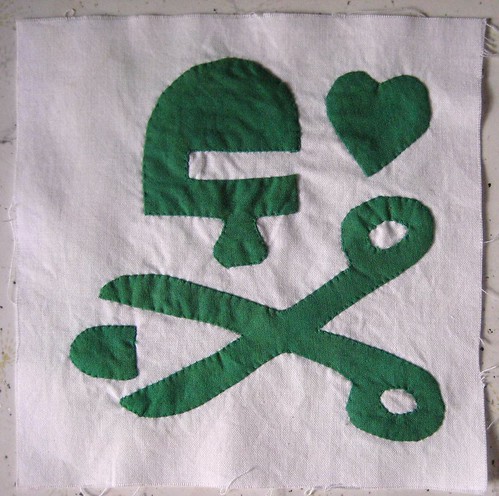
Unexpected ‘incidents’ with inset seams aside, it’s been far too long since I tried doing a historical reproduction block or learned a new skill. But I should have been smart enough not to try both in one go!
This picture, sticky and yellowed at the edges from a combination of time and cheap glue, has been sitting in my old visual diaries and nagging at me (‘Show me! Make me!). It’s part of an old photocopy I made while visiting America in 2002. I had two days to myself and spent them, nerd that I am, taking ridiculous numbers of photocopies at the New York Public Library: quilt books and out-of-print Richard Brautigan poetry. Ahh. Here is the full original: the block is at A6 (6th across, top row).

Way back then in the library, I fell in love with this sampler quilt. It’s long ago been separated from the notes I took of the maker(s) and even the title of the book it was in. I feel sure the block I chose to copy was done in Turkey red. It represents a hand (possibly, probably, traced from a real hand), wearing an abstract thimble and decorated with a heart.
These complex applique samplers were almost always done as gifts from a group of friends to a new bride or a departing friend, hence the heart. I think it’s a touching and imaginative design, one that I’ve not seen before nor since. I decided I’d like to copy it.
To make a block design, I took the photo above (a photo of a photocopy: classy) and blew it up by about 1000% on the PC. Then I traced the design on to fabric and proceeded to reverse applique the design. Nooooo… tried to reverse applique the design.
This method worked surprisingly well; it would be much more problematic for detailed picture blocks like Baltimores.

Somewhere along the line, I forgot that in the original block, the hand is skewed to face the corner. No problem, because the white fabric points where the fingers meet the hand is so knobbly and frayed that the block is unusable. You can see in the photo that the lines get wobbly there. The fabric is also bubbled and knobbly. One look at a quilting frame or a wash tub and this baby’s just lint.
I vastly underestimated this block’s degree of difficulty, and/or my decidedly average skill in applique. Plus, black thread was not a good choice. After I made the heart I switched to white, but the damage was done.
I’ve decided to go on a little self-guided applique course, starting with reading this book.
Despite trials and tribulations, I still think that this is a neat way of copying basic designs and I hope to use it in the future. I’m especially pleased with the results since the only image I have of the quilt is a terrible and tiny photocopy. But I want this block in my quilt — badly, I now realise — and I’m only waiting on applique skills before I can also make this composite block with figures from the Victoria and Albert Sundial Coverlet.

I’ll let you know how it goes… if you have mad applique skillz, please tell me how you learned them! A book I can read? A site I can look at? Don’t say ‘grandma taught me’ unless she lives in Brunswick and can be bribed to teach me. I have chocolate, jelly babies, and a decent stash of novelty egg cups.

















